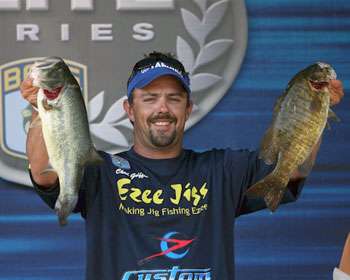
During the final event of the 2009 Bassmaster Elite Series regular season, rookie Chad Griffin took home the hardware with a combination of largemouth and smallmouth that he mined from New York's Oneida Lake. During the four days of competition, one of Griffin's main baits was a heavy grass jig. However, the grass jig is only effective under specific circumstances. When it comes to fishing rock and wood, Griffin deploys an entirely different arsenal.
When pitching jigs around rock and wood, Griffin's specialized grass jig goes back in the rod locker. Around riprap and rock, Griffin says, "Ninety-five percent of the time I'll be throwing a jig with a 4/0 hook and a little pea head." With the pea-shaped head design, Griffin says that the bait works over and through the rock better than any other head style without snagging. "A football head jig works great, except when you're dealing with big riprap, where it can fall into the crevices and hang up," he explains. "The pea head design slides over the rocks without becoming lodged in the cracks."
When targeting shallow rock, Griffin fishes a 5/16- or 3/8-ounce jig. The lighter jighead allows him to keep the bait from burying in the chunk rock. When fishing deep riprap, he will upgrade to a 7/16-ounce pea head jig.
Around wood, Griffin's go-to offering is an EZEE Jig Big Jig, a lure of his own design featuring an Arkie-style jighead. When flipping heavy cover or shallow boat docks, that style head crawls over logs and stumps without becoming lodged.
When flipping wood, the hook becomes crucial to landing bass hooked in heavy cover. His flipping jig sports a heavy gauge 5/0 round bend hook.
While a basic jig may appear to be little more than a hook, skirt and leadhead, subtle differences can make all the difference when it comes to putting more bass in the boat. Griffin says that the position and angle of the jig eye is critical. Rather than have the eye of the jig vertically positioned on the head of the jig, Griffin's EZEE Big Jig and finesse jig feature a horizontal line tie.
The purpose of the horizontal eye is to improve the chance that the bass will be hooked in the top of the mouth. "With the horizontal tie, the jig will rotate and drive through the roof of the bass' mouth on the hookset," explains Griffin. "When you hook a largemouth in the roof of the mouth, there's less of a chance that it will be able to throw the jig." Largemouth hooked in the side of the mouth are often able to open their mouths when jumping and tear the hook free. "If they're hooked in the side of the mouth, that's where you'll lose 90 percent of the fish on a jig. The sideways eye takes care of that."




